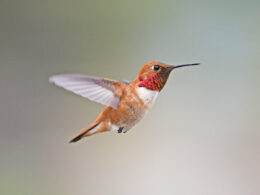Last Updated on January 19, 2024 by Greg Gillson
Did you see a brightly-colored red bird, orange bird, or yellow bird in Louisiana and wonder what is was?
This page is for you!
This article shows you photos and identification of some of the most common birds in Louisiana based on color.
The list of birds found in Louisiana includes over 475 species. So, I can’t show you all of them. I’m going to assume that you saw a common bird of this color, but you certainly could have seen something less common, or even rare!
Shape (including the shape of the bill) and size are often more helpful in starting to identify a bird than the color. In fact, most birds in North American can be easily identified with a black-and-white photo!
Many birds are multi-colored, so that it may be hard to pick out a dominant color. Males and females may be colored quite differently. And some color patterns are similar among otherwise dissimilar species.
Nevertheless, I’m going to try to pick out some of the birds that you are most likely to see in backyards or towns. And I’ll show a few others that I get asked about a lot
The birds with a noticeable amount of red on them in Louisiana covered in this article are:
- Northern Cardinal
- American Robin
- Ruby-throated Hummingbird
- House Finch
- Summer Tanager
- Purple Finch
The birds with a noticeable amount of orange on them in Louisiana covered in this article are:
- Brown Thrasher
- Barn Swallow
- Red-shouldered Hawk
- American Kestrel
- Eastern Towhee
- Orchard Oriole
- Cooper’s Hawk
- Wood Thrush
- American Redstart
- Ruddy Duck
- Rufous Hummingbird
The birds with a noticeable amount of yellow on them, including lots of yellow and black birds, in Louisiana covered in this article are:
- Yellow-rumped Warbler
- American Goldfinch
- Pine Warbler
- Northern Flicker
- Common Yellowthroat
- Great Crested Flycatcher
- Eastern Meadowlark
- Cedar Waxwing
- Northern Parula
- Prothonotary Warbler
- Hooded Warbler
- Yellow-breasted Chat
- Yellow-throated Vireo
- Dickcissel
- Kentucky Warbler
- Palm Warbler
- Pine Siskin
Red birds of Louisiana
Birds get the red, orange, and yellow in their feathers from carotenoids in the fruit, seeds, and plants they eat (source).
These carotenoid colors combine with melanin to form an infinite range of red feathers–pink, rusty, scarlet, violet, red-orange.
The following are red birds that you are most likely to see in Louisiana.
Northern Cardinal
These are one of the most common backyard birds in the eastern United States. Their bright red color and unique head profile makes them instantly identifiable to most people–whether they are bird watchers or not!
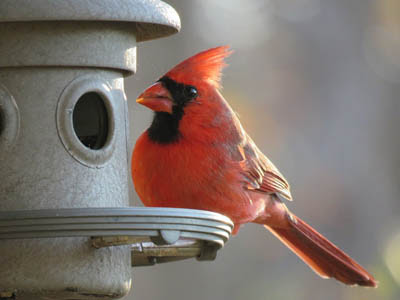 |
| Northern Cardinal. GeorgeB2 from Pixabay. |
Males of these large seed eaters are bright red with a black face and red crest.
Females replace most of the red with brown, The bill is large and orange.
These birds are found in woodlands, stream edges, residential areas.
Northern Cardinals year-round residents throughout Louisiana.
American Robin
These are familiar lawn birds with red breasts.
 |
| American Robin. Greg Gillson. |
Male American Robins are brownish-gray above with a brick red breast. Females are paler orange below and paler gray above.
They are widespread in open country with scattered deciduous trees, residential areas.
American Robins are year-round residents throughout most of Louisiana, winter visitors only in southernmost coastal areas.
Ruby-throated Hummingbird
These red-throated birds are the only hummingbird nesting in the eastern United States.

Males are dark green above and on the belly. They have a white upper chest. The throat is ruby-red.
Females are green above, white below, including white throat.
These birds are found in woodland edges, residential yards. Readily come to hummingbird feeders.
Ruby-throated Hummingbirds are summer residents throughout Louisiana, very rare year-round residents in southern coastal areas.
House Finch
When people ask about a bird with a red head at their feeder, it is usually this bird.
 |
| Male House Finch. Greg Gillson. |
Males of this dusty brown striped finch have red limited to the head (specifically the forehead and eyebrow), breast (chest), and rump. The red coloration tends toward orangish, and may rarely be yellowish.
Females are streaked, similar to the males but without red. They lack any strong pattern on the face and head.
Note the small round head and curved upper ridge on the bill.
Some people call these red-headed sparrows. Sparrows and finches are similar, but in general, male finches are brighter than the females and tend to hang out more in trees. Sparrow genders are usually quite similar in coloration and tend to feed mostly on the ground.
These birds are common in residential areas, especially at bird feeders. In the West more widespread in arid regions near water.
House Finches are year-round residents in southeastern Louisiana, and locally elsewhere in eastern and coastal southern Louisiana.
Summer Tanager
These bright red birds are found toward the tops of tall trees in the southern United States.

Males are rose red with fairly heavy bill.
Females are yellowish or mustard-colored, some with a faint reddish wash.
In the East these birds are found in pine-oak woodlands. In the West they prefer tall cottonwood trees.
Summer Tanagers are summer residents throughout Louisiana.
Purple Finch
Forest finches of the foothills, delicately frosted in pinkish-red.
 |
| Male Purple Finch. Greg Gillson. |
Told from more common House Finch by bigger square or peaked head, bigger bill, lacks sharp striping below, deeply notched tail. Red covers all plumage.
Females lack red color, shows strongly patterned dark ear patch outlined all around with a pale stripe, is heavily streaked below.
Found in foothills and damp mountains conifers and mixed woods. Visit feeders, but less frequently than House Finches.
Purple Finches are winter visitors throughout Louisiana.
Orange birds of Louisiana
True orange-colored birds are not that common. Many birds that I have here are paler rusty.
The common pattern is an orange body and black or brown wings and tail. Another common pattern is for the orange to be restricted to the under parts.
The following are orange birds that you are most likely to see in Louisiana.
Brown Thrasher
These are rather large rusty-orange songbirds.
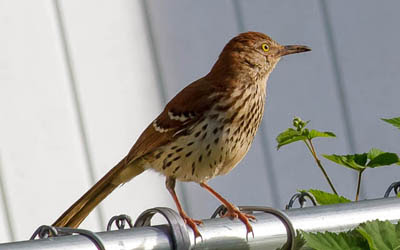 |
| Brown Thrasher. Linda Jones CC0. |
The upper parts of these birds is colored rusty-brown to orange. They show two white wing bars. Under parts are buff with heavy reddish-brown streaking.
These birds live in woodland edges and mature backyard landscaping.
Brown Thrashers are year-round residents throughout Louisiana.
Barn Swallow
These orange-bellied birds are a familiar sight across North America in summer.
 |
| Barn Swallow. Greg Gillson. |
These birds are purple-blue above with orange under parts and long forked tails. The color of the underparts in winter or on females are often cinnamon or buff-colored, but breeding males can be brighter orange-red.
These birds swoop low over fields and wetlands at lower elevations. They may build their mud nests in rafters on porches, garages, or other out-buildings.
Barn Swallows are summer residents throughout Louisiana.
Red-shouldered Hawk
Okay, the shoulders are reddish. But the rusty-orange breast and wing linings are barred red too.
 |
| Red-shouldered Hawk. Greg Gillson. |
The upper parts are barred black and white. The tail is banded black and white. In adults the breast is barred orange.
Immature birds are streaked with brown on the breast.
These birds like woodland edges, residential edges, riparian groves.
Red-shouldered Hawks are year-round residents throughout Louisiana.
American Kestrel
These are the familiar small rusty-orange falcons sitting on power lines on the edge of the highway, or hunting and hovering over the median strip.
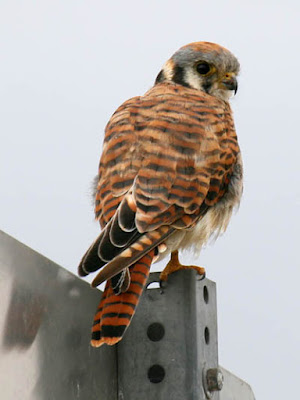 |
| Female American Kestrel. Greg Gillson. |
Females are rusty orange barred with black on their back wings and tail. The under parts are buff with black spots. The head shows two facial stripes.
Males have blue-gray backs and rufous tail is unmarked except for black tail band.
These birds are found in open country, farms, pastures with perches.
American Kestrels are winter visitors throughout Louisiana, year-round residents in northwestern Louisiana.
Eastern Towhee
These birds with rusty-orange sides like to hide in dense bushes.
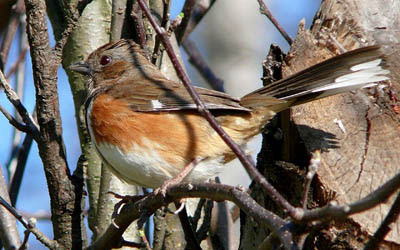 |
| Female Eastern Towhee. Skeeze. Pixabay. |
Males are black above with white wing patch, white tail corners. The sides are rusty. The belly white. Eyes variable: brown, red, orange, white, tending toward whiter southward.
Females are similar, but upper parts brown.
These birds are found in forest understory, dense brush, backyard hedges. Come to feeders.
Eastern Towhees are year-round residents throughout most of Louisiana, winter visitors only in southeastern Louisiana.
Orchard Oriole
Males of these orioles are darker rustier-orange than most other orioles in the United States.
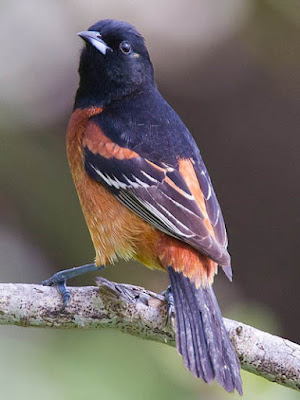 |
| Orchard Oriole. Dan Pancamo. Flikr. CC BY-SA 2.0 |
Males have a black hood and back, black wings and tail. The under parts are rusty-orange or even chestnut-brown.
Females are greenish above, lemon yellow below. They have 2 thin white wing bars. The bill is thinner than many other orioles.
They are found in orchards and residential shade trees.
Orchard Orioles are summer residents throughout Louisiana.
Cooper’s Hawk
These crow-sized hawks with reddish orange bars on the under parts may show up in fall or winter to hunt birds at your feeder. Oh no!
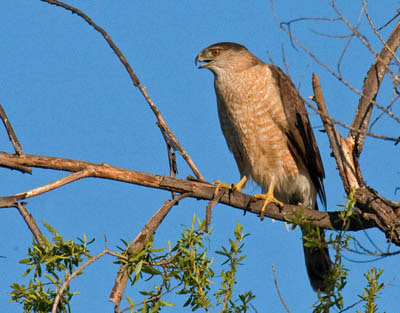 |
| Cooper’s Hawk. Greg Gillson. |
Adults with long gray and black banded tail. Dark gray above and cap on head. Under parts barred with rusty orange.
Immatures similar, brownish, streaked with brown on under parts.
Found in forests and woodlands, residential shade trees.
Cooper’s Hawks are year-round residents throughout most of Louisiana, winter visitors only in southernmost Louisiana.
Wood Thrush
These spotted birds with the orange-brown upper parts tend to hide in understory trees and on the forest floor.
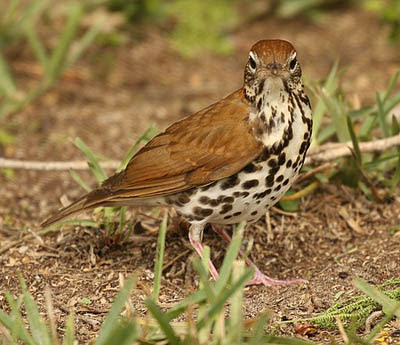 |
| Wood Thrush. Tony Castro. CC BY-SA 4.0 |
These birds are reddish brown on the upper parts, especially rusty orange on the crown and upper back. White eye ring. Large heavy black spots on the under parts.
They live in deciduous and mixed woods. Spend much time on the ground, shuffling through the leaf litter.
Wood Thrushes are summer residents throughout most of Louisiana, spring and fall migrants only in southernmost Louisiana.
American Redstart
In flight these small warblers flash orange or yellow in the wing and base of the tail.
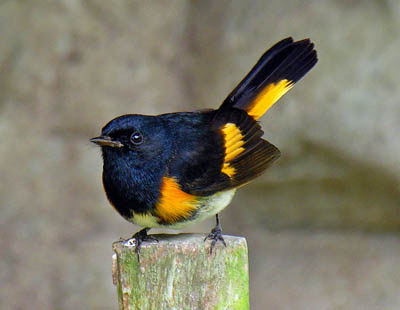 |
| American Redstart. Dennis Jarvis. Flikr. CC BY-SA 2.0 |
Males are black above, white on the belly. They have bright orange patches on side of breast, wings, and base of the tail.
Females are grayer, especially on the head. The orange of males is replaced by yellow on the females.
These birds are found in regenerating woods after a clear cut, and willow tangles along streams.
American Redstarts are summer residents throughout most of Louisiana, spring and fall migrants only in southernmost Louisiana.
Ruddy Duck
These small ducks are dark rusty-orange in spring.
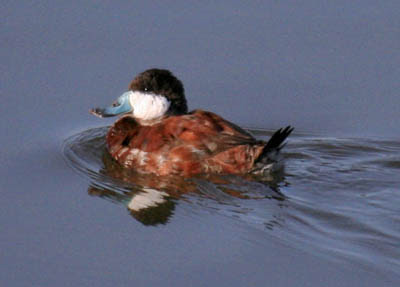 |
| Ruddy Duck. Greg Gillson. |
Males in breeding plumage (late winter and spring) are rusty, with a white face, and a blue bill. The long tail is often held sticking up. In winter they are brown, with white face, and dark bill.
Females all year are like winter males. Brown body, dark cap, dark line through eye of pale face. Dark bill.
These birds prefer weedy ponds to breed, but in winter may be found in deeper ponds in city parks.
Ruddy Ducks are winter visitors throughout Louisiana.
Rufous Hummingbird
These are the common widespread hummingbirds of the Pacific Northwest and Alaska. These orange birds don’t like to share the hummingbird feeder–frequent chases are the norm.
 |
| Rufous Hummingbird. Greg Gillson. |
Males are all-over rusty orange, tending to pinker cinnamon on the under parts. Even the back and rump and base of the tail feathers are orange. Males have a bright red throat gorget when the sunlight catches it just right.
Females are green above, with a small green or red spot in the center of the white throat. Flanks and sides cinnamon. Tail base orange.
These birds are found in forest edges, yards, in all but the highest mountains.
Rufous Hummingbirds are rare fall and winter visitors to extreme southern coastal Louisiana.
Yellow birds of Louisiana
Yellow is a common bird color! Often it is mixed with black and white plumage in birds.
Many birds with darker upper parts have yellow breast or belly.
The following are yellow birds you are most likely to see in Louisiana.
Yellow-rumped Warbler
These are abundant warblers across North America. Affectionately called “butter butts” by many birders, because of their bright yellow rumps that flash in flight.
 |
| Breeding Myrtle Yellow-rumped Warbler. Greg Gillson. |
Western form (Audubon’s) with bright yellow throat and yellow rump. Large white wing patch.
Northern and Eastern form (Myrtle) with white throat, yellow rump, and two white wing bars.
Winter birds are dull gray brown, with bright yellow rump. Throat may be cream colored or white. Often difficult to tell the two forms apart in winter.
 |
| Winter Yellow-rumped Warbler. Greg Gillson. |
Breed in mountain or boreal conifers. Widespread in migration. Winter in low river bottoms, open weedy deciduous areas. Rarely come to feeders in winter.
Yellow-rumped Warblers are winter visitors throughout Louisiana.
American Goldfinch
These small little birds are bright yellow and black.
 |
| American Goldfinch. Greg Gillson. |
Males are bright lemon yellow with black and white wings and tail, black cap. White under tail coverts. Pink bill.
Females are duller yellow below and brownish above. Lack black cap.
Winter birds are pale brown or gray, a touch of yellow on the throat of males.
These are birds of open country, fields with saplings, clear cuts, residential areas. They avoid dense forests, mountains, deserts. They visit feeders.
American Goldfinches are winter visitors throughout Louisiana, year-round residents in northern Louisiana.
Pine Warbler
This yellow and gray bird is one of the few warblers to visit feeders–and the only one to eat seeds!
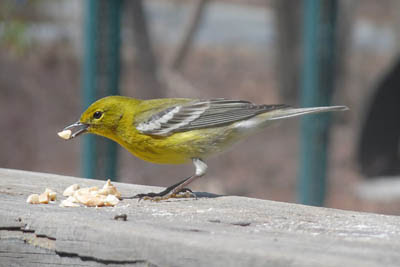 |
| Pine Warbler. Nikolaus Schultz. Pixabay. |
These birds are yellow-green on head, back, and breast. Wings blue-gray with wide white wing bars. Yellow split eye ring.
Strongly associated with pine forests. Usually high in tree tops.
Pine Warblers are winter visitors throughout Louisiana, year-round residents away from the coast in western and southeastern Louisiana.
Northern Flicker
These woodpeckers spend much time eating ants on the ground.
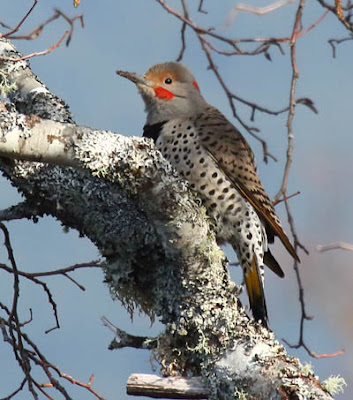 |
| Northern Flicker. Greg Gillson. |
These birds are larger than robins with brown and black barred upper parts. The underparts are pink with round black spots. There is a black crescent across the chest. When they fly away from you they reveal a large white rump.
Western birds have salmon-red under wings and under tail. Those in the East are colored yellow. The male face differs between the two populations–black whisker on the eastern birds, red whisker on western birds. Intergrades from overlap on Great Plains common. These may show male facial characteristics of both populations, or yellow-orange flight feathers.
These birds live in open woods with bare ground for foraging, residential yards.
Northern Flickers are year-round residents throughout Louisiana.
Common Yellowthroat
These buttery yellow birds are abundant in the marsh vegetation.
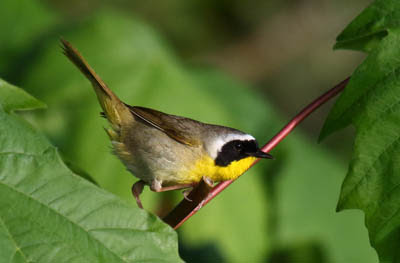 |
| Male Common Yellowthroat. Greg Gillson. |
These skulkers have bright yellow throats and yellow undertail coverts. Males have a black domino mask edged broadly in white, which females lack. Upperparts are dull olive-green.
Immature males in fall show a shadowed black mask.
Found in damp situations and heavy deciduous brambles following clear cuts.
Common Yellowthroats are summer residents throughout Louisiana, year-round residents in southern Louisiana.
Great Crested Flycatcher
These flycatchers have long tails and big heads with big bill and bright yellow belly.
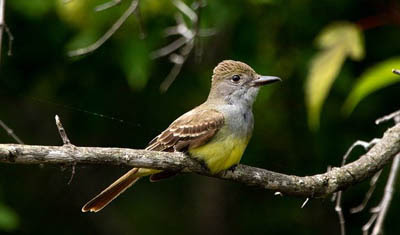 |
| Great Crested Flycatcher. Simard Francois. Pixabay. |
These birds are gray on the face and breast, brownish on rest of upper parts. Bright lemon yellow belly. The under side of the tail and some feathers of the wing are cinnamon colored.
These birds stay in the canopy of open woods.
Great Crested Flycatchers are summer residents throughout Louisiana.
Eastern Meadowlark
These pale brown birds with the brilliant yellow breasts are home on the ground in prairies. They sing from perches on isolated trees, power poles, fence posts.
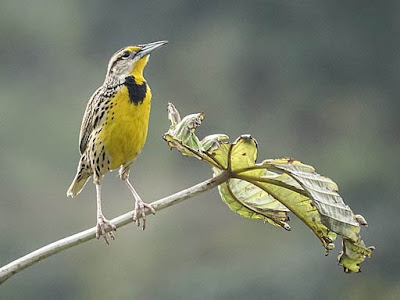 |
|
Eastern Meadowlark
Photo by Mike’s Birds from Riverside, CA, US [CC BY-SA 2.0]
|
The upper parts are streaked black, white, brown, so they blend into the dried grass where they live. The under parts are bright yellow with a black necklace across the chest. Very similar to Western Meadowlark, best told apart by spring song.
These birds live in prairies and extensive pasture lands.
Eastern Meadowlarks are year-round residents throughout Louisiana.
Cedar Waxwing
These crested birds with yellow band on the end of the tail are often found in flocks. They eat flying insects in summer, fruit and berries the rest of the year.
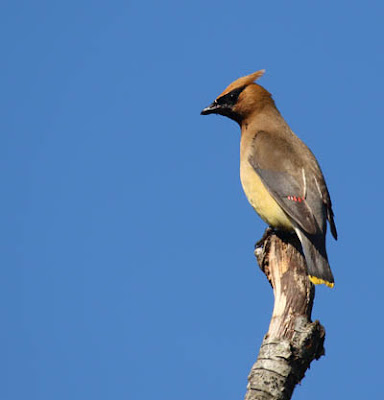 |
| Cedar Waxwing. Greg Gillson. |
These birds are fawn-brown above, with dark gray wings and tail. They have a black mask and wispy crest. The belly is yellow. The wings have waxy red drops on the end of the tertials. The end of the tail has a brilliant yellow tail band.
They are found in open habitats with berries, including juniper woodlands and towns in winter.
Cedar Waxwings are winter visitors throughout Louisiana.
Northern Parula
This is a handsome blue and yellow warbler.

Males are blue on the hood and shoulders. Back green. Yellow throat and breast with a dark red spot mid-chest. Broken white eye ring. Two wide white wing bars.
Females are similar, but paler.
They are found along streams and in swampy forests with willows, maples, birches, hemlocks and other trees.
Northern Parulas are summer residents throughout Louisiana.
Prothonotary Warbler
These bright yellow birds are found in southeastern swamps.
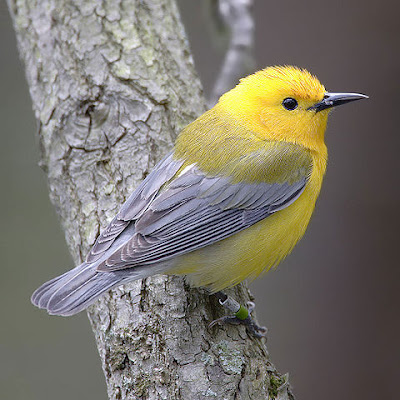 |
| Prothonotary Warbler. MDF. CC BY-SA 3.0 |
These birds are bright yellow with green back, gray wings and tail. The beady black eye stands out in the middle of the yellow face.
These birds stay low in the understory in swamps and bottomland forests, near or over water.
Prothonotary Warblers are summer residents throughout most of Louisiana, winter visitors only in southernmost Louisiana.
Hooded Warbler
These birds are found low down in the forest understory. They flash white tail corners.
 |
| Male Hooded Warbler. Christopher O’Toole. Pixabay. |
Males are dark green above with a black cowl over the crown and onto the throat. Face and under parts are bright yellow. White tail corners.
Females are similar, but lack the black of the male. The crown is green and the throat yellow.
These birds are found in deciduous woods and swamps, primarily in brushy understory.
Hooded Warblers are summer residents throughout Louisiana.
Yellow-breasted Chat
These unique larger yellow birds may sing day and night, and include whistles and crow-like cawing, often given in a display flight.
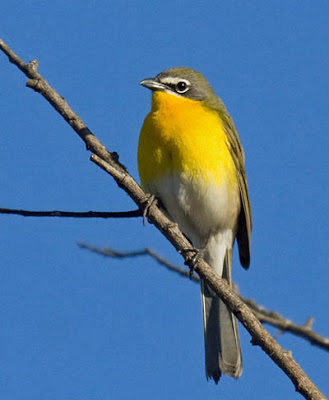 |
| Yellow-breasted Chat. Greg Gillson. |
These birds are greenish above with bright yellow breast and white belly. They have a dark mask bordered with white.
These birds live in tangles and wet woods.
Yellow-breasted Chats are summer residents throughout most of Louisiana, spring and fall migrants only through southernmost Louisiana.
Yellow-throated Vireo
Vireos are slow moving small birds that sing throughout the day. These yellow-headed vireos are one of the most colorful of their clan.
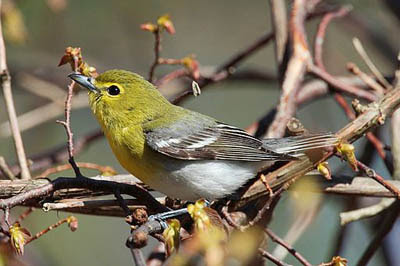 |
| Yellow-throated Vireo. MDF. CC BY-SA 3.0 |
These birds are blue-gray above, white below. Two white wing bars. Their head is olive yellow with yellow spectacles around the eye, and bright yellow throat.
These birds like large tracts of unbroken deciduous or mixed woodlands. Interestingly, however, they are often found on forest edges.
Yellow-throated Vireos are summer residents throughout the northern 2/3 of Louisiana, spring and fall migrants only in southern Louisiana.
Dickcissel
These yellow birds often flock together in weedy roadside edges.
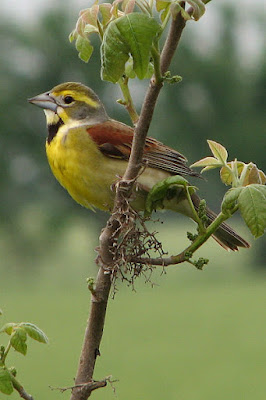 |
| Dickcissel. RebelAT. CC By-SA 3.0 |
These are gray birds with yellow breast and eyebrow.
Males have a black band across the lower throat. They have a large chestnut patch on the shoulder.
Females paler, lack black chest band.
They are found in prairie grasslands and weedy patches.
Dickcissels are summer residents in the northern half of Louisiana, spring and fall migrants only in southern Louisiana.
Kentucky Warbler
These birds with the yellow eyebrow and underparts are usually found low to the ground.
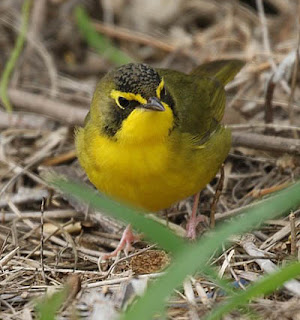 |
| Kentucky Warbler. Tony Castro. CC-BY-SA 4.0 |
These birds are green above and yellow below.
Males have a black cap and mask below the eye, forming a bright yellow eyebrow.
Females are similar, but the black on the head is not as dark.
They are found in dense understory in hardwood forests, often near streams.
Kentucky Warblers are summer residents throughout most of Louisiana, spring and fall migrants only in southern Louisiana.
Palm Warbler
This rather drab bird has bright yellow under tail coverts. It tends to spend much time on the ground in disturbed soils. It constantly bobs its tail up and down.
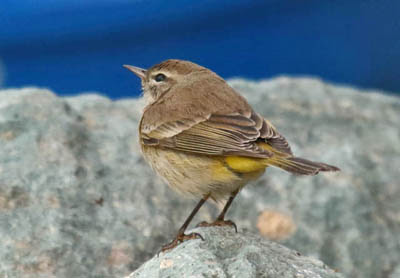 |
| Winter Palm Warbler. Greg Gillson. |
Breeding birds are rather gray with yellow throat, vent and under tail coverts. White eyebrow stripe. Chestnut cap. Eastern birds tend to be more yellowish on the breast.
In winter birds are very pale, but with yellow under tail.
They nest in bogs within boreal forests. They like similar habitat at other times of year: open land with isolated scrubby trees or bushes, including coastal scrub.
Palm Warblers are spring and fall migrants throughout the northern 2/3 of Louisiana, winter visitors only in southern Louisiana.
Pine Siskin
These small brown-streaked birds are relatives of the goldfinches. But you would never know it until they fly and sport yellow wing stripes and tail base. Usually in flocks.
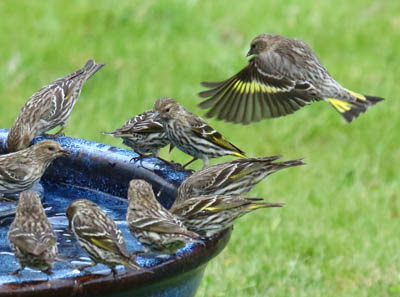 |
| Pine Siskin. Greg Gillson. |
These birds are streaked brown. In flight they have a yellow stripe down the length of the wing. The sides of the base of the tail is also yellow. Some birds are paler, some darker, others brighter yellow, others duller.
These birds are found in summer in northern conifer woods. Irregularly irrupt hundreds of miles southward. Frequent at feeders.
Pine Siskins are winter visitors throughout Louisiana, rare in the south.
Wrapping Up
If by some miracle you tire of looking at these gems of birds, Louisiana also has plenty of other interesting and stunning colored birds. Here are my favourite:
Eastern Wood-Pewee: These olive-green flycatchers serenade the woods with their melancholic “pee-a-wee” call, often perched on low branches, blending seamlessly with the foliage.
Louisiana Waterthrush: Energetic inhabitants of streams and swamps, their yellow-green upperparts flash as they flit alongside the water, singing a rapid, bubbly melody.
Eastern Bluebird: A splash of color against the sky, these dapper birds boast bright blue upperparts, rusty chests, and white bellies, charming listeners with their sweet, whistled songs.
Indigo Bunting: Dressed in dazzling blue with black faces and white wingbars, males woo their mates with high-pitched, buzzing songs from fields and shrubby areas.
Blue-gray Gnatcatcher: Tiny marvels with blue-gray upperparts and white underparts, flitting through trees and low shrubs, uttering thin, high-pitched “zeet” calls.
Mississippi Kite: These aerial acrobats, with their forked tails and piercing blue-gray eyes, glide effortlessly through open skies, hunting insects with graceful precision.
Frequently Asked Questions
What is the difference between yellow warbler and goldfinch?
While both the Yellow Warbler and American Goldfinch sport pops of yellow, they’re actually quite different birds! Here’s a breakdown of their key differences:
Appearance:
- Yellow Warbler:
- Slender build with a long, pointed tail.
- Males have bright yellow upperparts with chestnut streaks on the flanks, a bright yellow breast and throat, and two white wing bars.
- Females are duller yellow with less defined streaks and wing bars.
- American Goldfinch:
- Stockier build with a short, forked tail.
- Males have a vibrant yellow body during breeding season (spring and summer), with black wings, cap, and a white patch under the tail. Females are a duller yellow-green with brown wings and no black cap.
Habitat:
- Yellow Warbler: Prefers wooded swamps, bogs, and riparian areas with dense vegetation.
- American Goldfinch: Found in open fields, meadows, weedy gardens, and edges of woodlands.
Diet:
- Yellow Warbler: Primarily insectivorous, but also eats berries and seeds.
- American Goldfinch: Primarily eats seeds, including thistle and sunflowers.
Song:
- Yellow Warbler: Sings a high-pitched, buzzy “sweet-sweet-sweet-sweet-swwee,” often sung repeatedly from treetops.
- American Goldfinch: Has a high-pitched, tinkling song with varied calls, including a distinctive “per-chic-o-ree.”
Distribution:
- Yellow Warbler: Breeds in North America and migrates to Central and South America for the winter.
- American Goldfinch: Found year-round in most of North America, with some populations migrating south in winter.
How long do Orioles stay in Louisiana?
Orioles’ stay in Louisiana varies depending on the species and individual bird, but generally follows a migratory pattern:
Baltimore Orioles:
- Arrival: Mid-April to early May
- Departure: Early July to late August
- Total stay: Roughly 3-4 months
Orchard Orioles:
- Arrival: Late March to early April
- Departure: October to November
- Total stay: About 6-8 months
Factors influencing length of stay:
- Weather: Early warm springs might mean birds arrive earlier and vice versa.
- Food availability: Abundant food sources can encourage a longer stay.
- Breeding success: Raising young may delay or hasten departure.
- Individual variations: Each bird has its own migratory timeline.
What kind of bird has a red head in Louisiana?
Summer Tanagers are delightful splashes of bright red in Louisiana’s summertime birdlife! Finding them isn’t too tricky, as they have specific preferences for habitat and timing. Here’s a guide to help you track them down:
When to Look:
- Arrival: April-May
- Departure: Mid-to-late October
- Peak Season: June-August, when males are in full breeding plumage and most vocal.
Where to Look:
- Habitat:
- Open woods, especially oak, hickory, and pine forests.
- Woodland edges and clearings.
- Riparian woodlands along streams and rivers.
- Brushy roadsides and overgrown fields.
- Mature gardens and parks with large trees.
- Specific Locations:
- Kisatchie National Forest: Diverse habitats with plenty of open woodlands.
- Sabine National Wildlife Refuge: Perfect for spotting them along wooded trails.
- Lake Bistineau State Park: Known for its mature hardwood forests and abundant birdlife.
- Natchitoches Parish: Known as the “Summer Tanager Capital of Louisiana.”
- Your own backyard: If you have large trees with ripe fruit, you might attract them!
Related Articles:
See photos and learn about the most common backyard birds in Louisiana, regardless of color.
See photos and learn what to feed winter birds in Louisiana. [Coming soon!]
Here’s a quick tutorial of how I would teach you to identify birds: 7 Steps to Identify Birds!
Birds with red heads in North America.
Yellow-and-black birds in North America.
Little Brown Birds at your Feeder.







